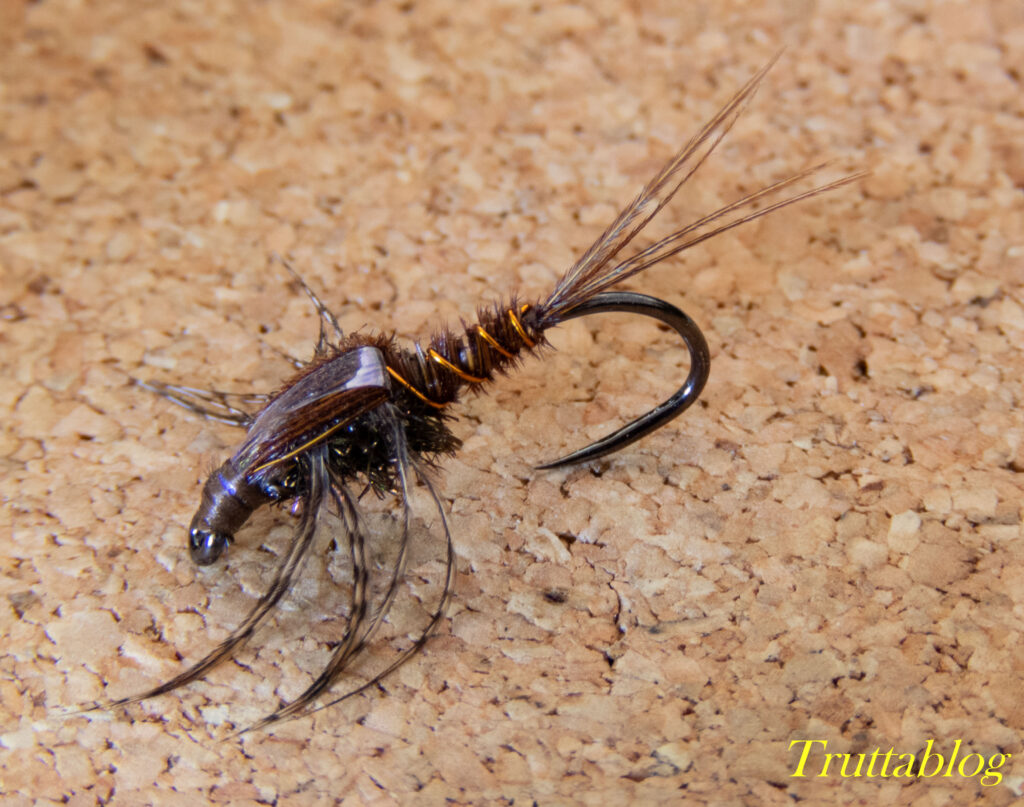I started out the morning with a #16 ant pattern in the dropper position, on some 7X tippet, and trailing about two foot below that, a #20 Pheasant Tail nymph with a small matt tungsten bead on it.


The flow was quick enough that the point fly didn’t sink the ant over a 10 to 15 foot drift and a fish went for the ant on the second drift. The problem was that I couldn’t see the ant. When you can’t see the dry fly, the take surprises you, and that slows your strike time to the point where you will most likely miss the fish. I could have added a drift indicator (AKA Strike indicator), to help me locate the dry…a kind of reference point, but knowing these small fish, some of them would take that instead of the dry. I hooked a small fish on the very next drift on the nymph. I had managed to track the dry on that particular drift and its sudden disappearance was my signal to lift into the fish. But soon after that I got tired of trying to find the dry on the surface, so I pulled it in and put on a parachute dry , tied with pale grey CDC halo hackle.

Since the fish were looking up, and the parachute was on a barbless hook, I left the nymph on my fly patch for later, and just fished the parachute on its own.
That worked, and I landed several fish in the next two runs. Then the fish began to ignore the dry. I switched to something with a barb, that I could quickly tie the little nymph back onto, with its piece of 7X still trailing from my patch. That was a #14 Ed’s Hopper, which I chose because it had a highly visible red wing, and because the breeze was blowing hard enough to imagine that a hopper might land in the stream. From mid-December onwards, there tend to be enough hoppers around that I can fish the Ed’s Hopper without feeling like I am fishing an attractor pattern.

The fish continued to ignore the dry, and I did begin to wonder if they might have had a go at the parachute pattern if I have left it on. I do that a lot: second guess and start to doubt the wisdom of my fly change. Anyway, I had some fish go at the nymph on the point. I missed two of them, merely seeing a flash below the surface. A flash that I think a great many anglers probably don’t even see, especially if they are diligently locking their vision onto the floating indicator fly. Then I landed a fish on the point fly. Soon after, I switched the dropper to a larger nymph (#14), lengthened the distance between the two flies, and put a yarn indicator on.

That larger nymph, a slightly different looking Pheasant Tail Nymph, was heavy in the hand, but in fishing it, I quickly realized that the point fly was sinking much faster, and that the larger and seemingly heavier dropper fly, was in fact not helping things and was staying high in the water column.

Let’s dwell on that a moment. If you closed your eyes and dropped first the #20 point fly into your palm, and then the #14 dropper fly, you would quite correctly say that the larger fly was heavier. It was. But it was less dense. In other words, the size/weight ratio didn’t match that of the smaller fly. In fishing these two, the difference in sink rate was remarkable. Both were tied to 7X tippet, but that point fly was plummeting compared to the bigger pattern. The thing is, that the bigger pattern probably would have needed a 3mm tungsten bead on it to match the density of the point fly, and I didn’t want to be throwing a 3mm bead on my 2 weight outfit. So I changed a few things. I put on a more dense #16 dropper fly. I also started using a tuck cast, and I was careful to add enough slack in the cast by employing a bounce into the tuck cast. (Cast hard and stop suddenly so the fly bounces back, and at the same time end the cast with the rod high and tilt it down to point at the water from on high as it rolls out….it bounces back, and the flies enter the water column first) . So now I had two small, deep nymphs, fished under an indicator, light enough to throw on the two weight with pleasure. All set.
The problem is, I stopped catching fish. My colleague, who was employing different tactics altogether, also stopped catching. Learning that from him surely saved me from a time occupied more by fly changes than fishing. It is useful to share some info with mates. So I settled into focusing on where to find the fish, and I concentrated on some concealment and reducing my false casting. I also played around with distance…standing further back and battling drag with longer drifts, and then later, getting in close with short casts, but kneeling in the stream behind rocks.

Before I knew it, we were five hours into the day, we had covered I think 2 km of river, and our agreed departure time had already passed. Five hours of mental absorption and puzzle solving, in clear mountain air, with cold clean water tugging at my legs, and without a thought of work, or the world’s troubles.

Total immersion and distraction, and fuel for several days of mulling and musing. Isn’t this flyfishing thing a glorious pastime!